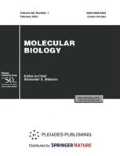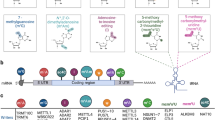Abstract
Protein splicing is a posttranslational process that results in excision of an internal protein region (intein) and ligation of its flanking sequences (exteins). As distinguished from other variants of protein processing, protein splicing does not require cofactors of enzymes. Protein splicing is catalyzed by an internal domain (so-called Hint domain) of the intein itself. The review considers the main regularities and molecular mechanisms of the process, as well as the functions of Hint domains in other protein families (Hh proteins, bacterial BIL domains, etc.). Studies of protein splicing are of importance from both theoretical and applied viewpoints. For instance, comparisons of the inteins found in different domains of life illustrate the role of horizontal transfer in intein spreading. A possible role of inteins in regulating several cell processes is discussed on the basis of recent data.
Similar content being viewed by others
References
Kane P.M., Yamashiro C.T., Wolczyk D.F., Neff N., Goebl M., Stevens T.H. 1990. Protein splicing converts the yeast TFP1 gene product to the 69 kDA subunit of the vacuolar H+-adenosine triphosphatase. Science. 250, 651–657.
Anraku Y., Mizutani R., Satow Y. 2005. Protein splicing: Its discovery and structural insight into novel chemical mechanisms. IUBMB Life. 57, 563–574.
Perler F., Davis E., Dean G., Gimble F., Jack W., Neff N., Noren C., Thorner J., Belfort M. 1994. Protein splicing elements: Inteins and exteins, a definition of terms, and recommended nomenclature. Nucleic Acids Res. 22, 1125–1127.
Klabunde T., Sharma S., Telenti A., Jacobs W., Sacchettini J. 1998. Crystal structure of GyrA intein from Mycobacterium xenopi reveals structural basis of protein splicing. Nature Struct. Biol. 5, 31–36.
Noren C., Wang J., Perler F. 2000. Dissecting the chemistry of protein splicing and its applications. Angew. Chem. Int. Ed. 39, 450–466.
Perler F. 2005. Protein splicing mechanisms and applications. IUMBM Life. 57, 469–476.
Yang J., Meng Q., Liu X. 2004. Intein harbouring large tandem repeats in replicative DNA helicase of Trichodesmium erythraeum. Mol. Microbiol. 51, 1185–1192.
Pietrokovski S. 1994. Conserved sequence features of inteins (protein introns) and their use in identifying new inteins and related proteins. Protein Sci. 3, 2340–2350.
Perler F. 2002. InBase, the intein database. Nucleic Acids Res. 30, 383–384.
Perler F., Olsen G., Adam E. 1997. Compilation and analysis of intein sequences. Nucleic Acids Res. 25, 1087–1093.
Pietrokovski S. 1998. Modular organization of inteins and C-terminal autocatalytic domains. Protein Sci. 7, 64–71.
Ding Y., Xu M., Ghosh I., Chen X., Ferrandon S., Lesage G., Rao Z. 2003. Crystal structure of a miniintein reveals a conserved catalytic module involved in side chain cyclization of asparagine during protein splicing. J. Biol. Chem. 278, 3913–3914.
Matsumura H., Takahashi H., Inoue T., Yamamoto T., Hashimoto H., Nishioka M., Fujiwara S., Takagi M., Imanaka T., Kai Y. 2006. Crystal structure of intein homing endonuclease II encoded in DNA polymerase gene from hyperthermophilic archaeon Thermococcus kodakaraensis strain KOD1. Proteins. 63, 711–715.
Guhan N., Muniyappa K. 2003. Mycobacterium tuberculosis RecA intein, a LAGLIDADG homing endonuclease, displays Mn2+-and DNA-dependent ATPase activity. Nucleic Acids Res. 31, 4184–4191.
Ghosh I., Sun L., Xu M. 2001. Zinc inhibition of protein trans-splicing and identification of regions essential for splicing and association of a split intein. J. Biol. Chem. 276, 24,051–24,058.
Choi J.J., Nam K.H., Min B., Kim S.J., Soll D., Kwon S.T. 2006. Protein trans-splicing and characterization of a split family B-type DNA polymerase from the hyperthermophilic archaeal parasite Nanoarchaeum equitans. J. Mol. Biol. 356, 1093–1106.
Clarke N. 1994. A proposed mechanism for the self-splicing of proteins. Proc. Natl. Acad. Sci. USA. 91, 11,084–11,088.
Shao Y., Xu M., Paulus H. 1996. Protein splicing: Evidence for an N-O acyl rearrangement as the initial step in the splicing process. Biochemistry. 35, 3810–3815.
Mills K.V., Perler F.B. 2005. The mechanism of inteinmediated protein splicing: Variations on a theme. Protein Peptide Lett. 12, 751–755.
Xu M.Q., Coimb D.G., Paulus H., Noren J.C., Shao Y., Perler F.B. 1994. Protein splicing: An analysis of the branched intermediate and its resolution by succnimide formation. EMBO J. 13, 5517–5522.
Sun P., Ye S., Ferrandon S., Evans T.C., Xu M.Q., Rao Z. 2005. Crystal structures of an intein from the split dnaE gene of Synechocystis sp. PCC6803 reveal the catalytic model without the penultimate histidine and the mechanism of zinc ion inhibition of protein splicing. J. Mol. Biol. 353, 1093–1105.
Wang S., Liu X. 1997. Identification of an unusual intein in chloroplast ClpP protease of Chlamydomonas eugametos. J. Biol. Chem. 272. 11,869–11,873.
Perler F.B. 1999. A natural example of protein trans-splicing. Trends Biochem. Sci. 24, 209–211.
Khan M.S., Khalid A.M., Malik K.A. 2005. Intein-mediated protein trans-splicing and transgene containment in plastids. Trends Biotechnol. 23, 217–220.
Flick K.E., Jurica M.S., Monnat R.J., Stoddard B.L. 1998. DNA binding and cleavage by the nuclear intronencoded homing endonuclease I-PpoI. Nature. 394, 96–101.
Gimble F.S., Duan X., Hu D., Quiocho F.A. 1998. Identification of Lys-403 in the PI-SceI homing endonuclease as part of a symmetric catalytic center. J. Biol. Chem. 273, 30,524–30,529.
Dalgaard J.Z., Klar A.J., Moser M., Holley W.R., Chatterjee A., Mian I.S. 1997. Statistical modeling and analysis of the LAGLIDADG family of site-specific endonucleases and indentification of an intein that encodes a site-specific endonuclease of the HNH family. Nucleic Acids Res. 25, 4626–4638.
Bakhrat A., Jurica M., Stoddard B., Raveh D. 2004. Homology modeling and nutational analysis of Ho endonuclease of yeast. Genetics. 166, 721–728.
He Z., Crist M., Yen H., Duan X., Quiocho F.A., Gimble F.S. 1998. Amino acid residues in both the protein splicing and endonuclease domains of the PI-SceI intein mediate DNA binding. J. Biol. Chem. 273, 4607–4615.
Lykke-Andersen J., Garrett R.A., Kjems J. 1996. Protein footprinting approach to mapping DNA binding sites of two archaeal homing enzymes: evidence for a two-domain protein structure. Nucleic Acids Res. 24, 3982–3989.
Hu D., Crist M., Duan X., Quiocho F.A., Gimble F.S. 2000. Probing the structure of the PI-SceI-DNA complex by affinity cleavage and affinity photocrosslinking. J. Biol. Chem. 275, 2705–2712.
Pietrokovski S. 2001. Intein spread and extinction in evolution. Trends Genet. 17, 465–472.
Adam E., Perler F. 2002. Development of a positive genetic selection system for inhibition of protein splicing using mycobacterial inteins in Escherichia coli DNA gyrase subinit A. J. Mol. Microbiol. Biotechnol. 4, 479–487.
Hall T.M., Porter J.A., Young K.E., Koonin E.V., Beachy P.A., Leahy D.J. 1997. Crystal structure of a Hedgehog autoprocessing domain: homology between Hedgehog and self-splicing proteins. Cell. 91, 85–97.
Porter J.A., Ekker S.C., Park W.J., von Kessler D.P., Young K.E., Chen C.H., Ma Y., Wood A.S., Cotter R.J., Koonin E.V., Beachy P.A. 1996. Hedgehog patterning activity: Role of a lipophilic modification mediated by the carboxy-terminal autoprocessing domain. Cell. 86, 21–34.
Komori K., Fujita N., Ichiyanagi K., Shinagawa H., Morikawa K., Ishino Y. 1999. PI-PfuI and PI-PfuII, intein-coded homing endonucleases from Pyrococcus furiosus. Nucleic Acids Res. 27, 4167–4182.
Butler M., Goodwin T., Poulter R. 2005. Two new fungal inteins. Yeast. 22, 493–501.
Butler M.I., Gray J., Goodwin T.J., Poulter R.T. 2006. The distribution and evolutionary history of the PRP8 intein. BMC Evol. Biol. 6, 42.
Bjornsdottir S.H., Blondal T., Hreggvidsson G.O., Eggertsson G., Petursdottir S., Hjorleifsdottir S., Thorbjarnardottir S.H., Kristjansson J.K. 2006. Rhodothermus marinus: Physiology and molecular biology. Extremophiles. 10, 1–16.
Khan M.S., Khalid A.M., Malik K.A. 2005. Intein-mediated protein trans-splicing and transgene containment in plastids. Trends Biotechnol. 23, 217–220.
Hertveldt K., Lavigne R., Pleteneva E., Sernova N., Kurochkina L., Korchevskii R., Robben J., Mesyanzhinov V., Krylov V.N., Volckaert G. 2005. Genome comparison of Pseudomonas aeruginosa large phages. J. Mol. Biol. 354, 536–545.
Nagasaki K., Shirai Y., Tomaru Y., Nishida K., Pietrokovski S. 2005. Algal viruses with distinct intraspecies host specificities include identical intein elements. Appl. Environ. Microbiol. 71, 3599–3607.
Suhre K., Audic S., Claverie J.M. 2005. Mimivirus gene promoters exhibit an unprecedented conservation among all eukaryotes. Proc. Natl. Acad. Sci. USA. 102, 14689–14693.
Ogata H., Raoult D., Claverie J.M. 2005. A new example of viral intein in Mimivirus. Virol. J. 2, 1–7.
Gogarten J., Senejani A., Zhaxybayeva O., Olendzenski L., Hilario E. 2002. Inteins: Stcructure, function, and evolution. Annu. Rev. Microbiol. 56, 263–287.
Liu X., Yang J., Meng Q. 2003. Four Inteins and three group II introns encoded in a bacterial ribonucleotide reductase gene. J. Biol. Chem. 278, 46,826–46,831.
Paulus H. 2001. Inteins as enzymes. Bioorg. Chem. 29, 119–129.
Paulus H. 2000. Protein splicing and related forms of protein autoprocessing. Annu. Rev. Biochem. 69, 447–496.
Ingham P.W., McMahon A.P. 2001. Hedgehog signaling in animal development: Paradigms and principles. Genes Devel. 15, 3059–3087.
Roessler E., Belloni E., Gaudenz K., Vargas F., Scherer S.W., Tsui L.C., Muenke M. 1997. Mutations in the C-terminal domain of Sonic Hedgehog cause holoprosencephaly. Hum. Mol. Genet. 6, 1847–1853.
Amitai G., Belenkiy O., Dassa B., Shainskaya A., Pietrokovski S. 2003. Distribution and function of new bacterial intein-like protein domains. Mol. Microbiol. 47, 61–73.
Dassa B., Haviv H., Amitai G., Pietrokovski S., 2004. Protein splicing and auto-cleavage of bacterial inteinlike domain lacking a C′-flanking nucleophilic residue. J. Biol. Chem. 30, 32001–32007.
Parkhill J., Achtman M., James K.D., Bentley S.D., Churcher C., Klee S.R. 2000. Complete DNA sequence of a serogroup A strain of Neisseria meningitides Z2491. Nature. 404, 502–506.
Salanoubat M., Genin S., Artiguenave F., Gouzy J., Mangenot S., Arlat M. 2001. Genome sequence of the plant pathogen Ralstonia solanacearum. Nature. 415, 497–502.
Albert A., Dhanaraj V., Genschel U., Khan G., Ramjee M.K., Pulido R., Sibanda B.L., von Delft F., Witty M., Blundell T.L., Smith A.G., Abell C. 1998. Crystal structure of aspartate decarboxylase at 2.2 Å resolution provides evidence for an ester in protein self-processing. Nature Struct. Biol. 5, 289–293.
Author information
Authors and Affiliations
Additional information
Original Russian Text © P.L. Starokadomskyy, 2007, published in Molekulyarnaya Biologiya, 2007, Vol. 41, No. 2, pp. 314–330.
Rights and permissions
About this article
Cite this article
Starokadomskyy, P.L. Protein splicing. Mol Biol 41, 278–293 (2007). https://doi.org/10.1134/S0026893307020094
Received:
Accepted:
Issue Date:
DOI: https://doi.org/10.1134/S0026893307020094




